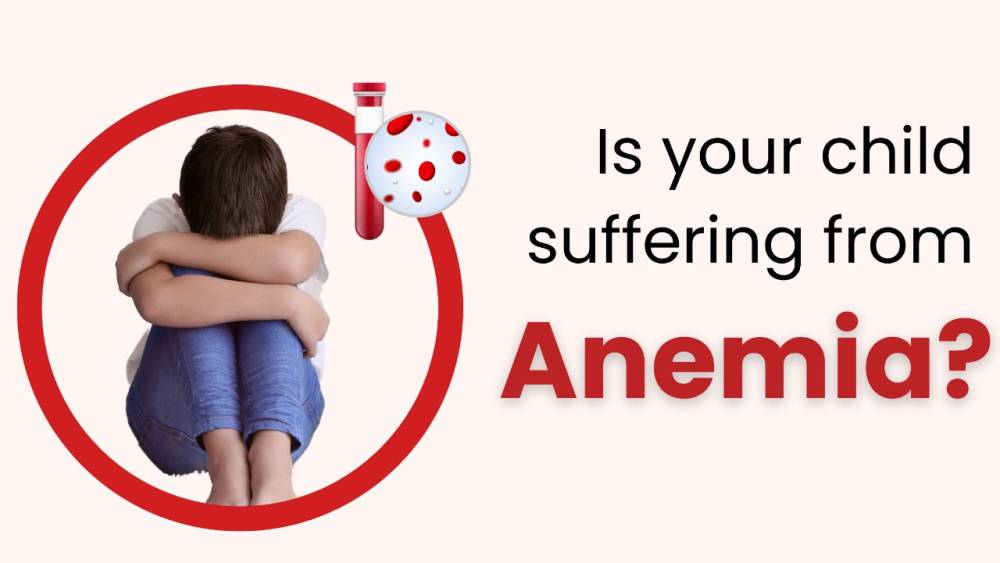
Anemia in Children: Type, Symptoms, Cause and Prevention Tips
Anemia is a condition in which the body doesn’t have enough RBC or Haemoglobin which gives rise to several health complications such as breathlessness, tiredness, Slow body growth etc. In 2019, the global prevalence of anemia in children aged 6-59 months (about 5 years) was 39.8%, equivalent to 269 million children with anemia. It occurs when the body lacks enough healthy red blood cells to carry sufficient oxygen to the body's tissues. This can lead to a variety of symptoms and health issues. Understanding anemia and its impact on children is essential to provide proper care and support.
Source: Our World in Data
Several types of anemia commonly affect children. These include:
According to the World Health Organization (WHO), iron deficiency anemia affects nearly 1.2 billion people globally, with 475 million children under five years old suffering from the condition
Iron-deficiency anemia is the most common type of anemia in children. It occurs when the body doesn't have enough iron to produce sufficient red blood cells. Iron is crucial for the formation of hemoglobin, the protein in red blood cells that carries oxygen. Without enough iron, the body struggles to produce healthy red blood cells, leading to anemia.
Megaloblastic Anemia
Megaloblastic anemia is another type frequently seen in children. It occurs when the body lacks adequate levels of vitamin B12 or folate. These nutrients are crucial for the production of red blood cells; without them, the red blood cells produced are larger than normal and unable to function effectively.
Hemolytic Anemia
Hemolytic anemia occurs when the body prematurely destroys red blood cells. Various factors, such as autoimmune disorders, infections, or certain medications can cause this. The destruction of red blood cells leads to a deficiency and subsequent anemia.
1.jpg)
Signs of Anemia in Children
Recognizing the signs of anemia in children is crucial for early detection and treatment. Some common signs and symptoms include:
* Fatigue and tiredness
* Weakness and pale skin
* Shortness of breath and rapid heartbeat
* Dizziness and fainting
* Cold hands and feet
* Headaches and trouble concentrating
* Delayed growth and development
* Irritability and mood swings
If you notice any of these symptoms in your child, it's important to consult a healthcare professional for proper evaluation and diagnosis.
Causes of Anemia in Children
Anemia in children can have various causes. Some common factors include:
* Inadequate dietary intake of iron, vitamin B12, or folate
* Chronic illnesses that affect the body's ability to produce or use red blood cells
* Blood loss due to injury, surgery, or gastrointestinal conditions
* Inherited disorders that affect red blood cell production or function
It's important to identify the underlying cause of anemia to implement appropriate treatment and prevention strategies.
Prevention Strategy
Preventing anemia in children involves a combination of dietary modifications and lifestyle choices. Here are some strategies that can help:
Ensuring a balanced diet is crucial for preventing anemia. Encourage your child to consume iron-rich foods such as lean meats, beans, fortified cereals, and leafy green vegetables. Including vitamin C-rich foods, such as citrus fruits, can also enhance iron absorption.
In some cases, iron supplementation may be necessary, particularly if dietary intake alone isn't sufficient. Consult with a healthcare professional to determine the appropriate dosage and duration for your child.
Regular Check-ups
Regular check-ups with a pediatrician can help monitor your child's health and identify any potential signs of anemia. Blood tests can assess the levels of iron and other important nutrients in the body.
Treatment Options
The treatment of anemia in children depends on the underlying cause and severity. In addition to dietary changes and iron supplementation, other treatment options may include:
Blood transfusions: In severe cases of anemia, a blood transfusion may be necessary to replenish the red blood cell count.
Medications: If anemia is caused by an underlying medical condition, medications may be prescribed to address the underlying cause.
Management of chronic conditions: For children with chronic illnesses that contribute to anemia, proper management of the underlying condition is essential for preventing and treating anemia.
One innovative tool that can aid in the management of anemia is EzeCheck by EzeRx. This user-friendly device allows caregivers to monitor and track their child's hemoglobin level at home, offering convenience and peace of mind.
Conclusion
In conclusion, anemia in children is a widespread health concern with substantial implications for their well-being. Identifying the symptoms, comprehending the various types, and implementing effective prevention and treatment strategies are imperative for optimal care. With the right support and interventions, children grappling with anemia can flourish and enjoy robust health. Always seek personalized advice and guidance from healthcare professionals to ensure the best possible outcomes for your child's health and use EzeCheck for continuous monitoring of your child’s Hemoglobin level.